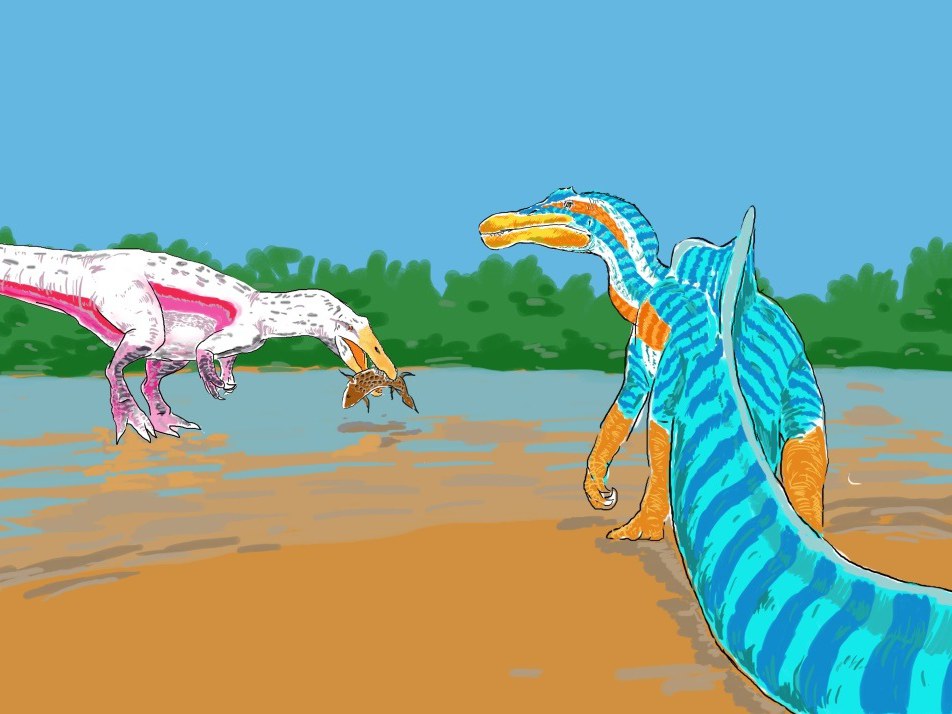Spinosaurs (family Spinosauridae) are large to giant carnivorous dinosaurs that have been familiar to a wide audience since the third film in the Jurassic Park series at the latest. Spinosaurs were often larger than Tyrannosaurus rex! They have a long crocodile-like skull and conical teeth that are also reminiscent of crocodiles. The animals probably ate large fish but also other dinosaurs. Spinosaurs were found almost all over the world, and so some time ago teeth were found in Thailand, which were named Siamosaurus suteethorni. Teeth are, however, hardly suitable for determining the species and so the validity of this spinosaur species has often been questioned since the remains of the skeleton have never been discovered.
"When I was a doctoral student at the University of Bonn, I found a tail piece made of eight vertebrae lying unnoticed in a drawer in the Sirindhorn Museum in Thailand," says Dr. Adun Samathi, head of the project. The vertebra looks similar to that of Camarillasaurus from Spain. Camarillasaurus was originally assigned to the so-called ceratosaurs, which also includes Ceratosaurus and Carnotaurus. "But this assignment of Camarillasaurus was problematic because its morphology is more similar to spinosaurids, including Thai material, than to ceratosaurs," says Samathi. Therefore, Camarillasaurus has been re-examined to better understand the Thai dinosaur.
Things became clearer when Prof. Martin Sander from the University of Bonn, who was supervising Samathi's doctoral thesis, traveled to Thailand and sifted through the Thai material. Sander realized that other theropod caudal vertebrae from the same site resemble the famous Baryonyx. The latter is a spinosaur that was found in Europe, first in England and later in Portugal. It was then that the team realized that they were on the right track.
After examining dinosaur finds kept in various museums in the United States, Italy, Germany, Portugal, and Japan, the team found that Camarillasaurus actually belongs to the spinosaur family. The new caudal vertebrae from Thailand not only confirm the presence of spinosaurs on Phu Wiang Mountain, but also led to a further finding: Apparently, more than one species of these huge predators frequently occurred together, as with Camarillasaurus and Baryonyx two spinosaurs occupied the Iberian Peninsula in the Early Cretaceous. This pattern is also known from Brazil and Morocco. And in Southeast Asia, in addition to Siamosaurus, there is Ichthyovenator from Laos, or even three species, if the new spinosaur tail should not belong to Siamosaurus. Considering the multitude of prey grabber, a not very encouraging idea for a time traveler. However, the team hopes to find more fossils in the future that will answer these questions.
Publication: Adun Samathi, P. Martin Sander, and Phornphen Chanthasit: A spinosaurid from Thailand (Sao Khua Formation, Early Cretaceous) and a reassessment of Camarillasaurus cirugedae from the Early Cretaceous of Spain, Historical Biology, https://doi.org/10.1080/08912963.2021.1874372
Contact for the media:
Prof. Dr. Martin Sander
Institut für Geowissenschaften
Universität Bonn
Tel. +49-(0)228/733105
E-Mail: martin.sander@uni-bonn.de





